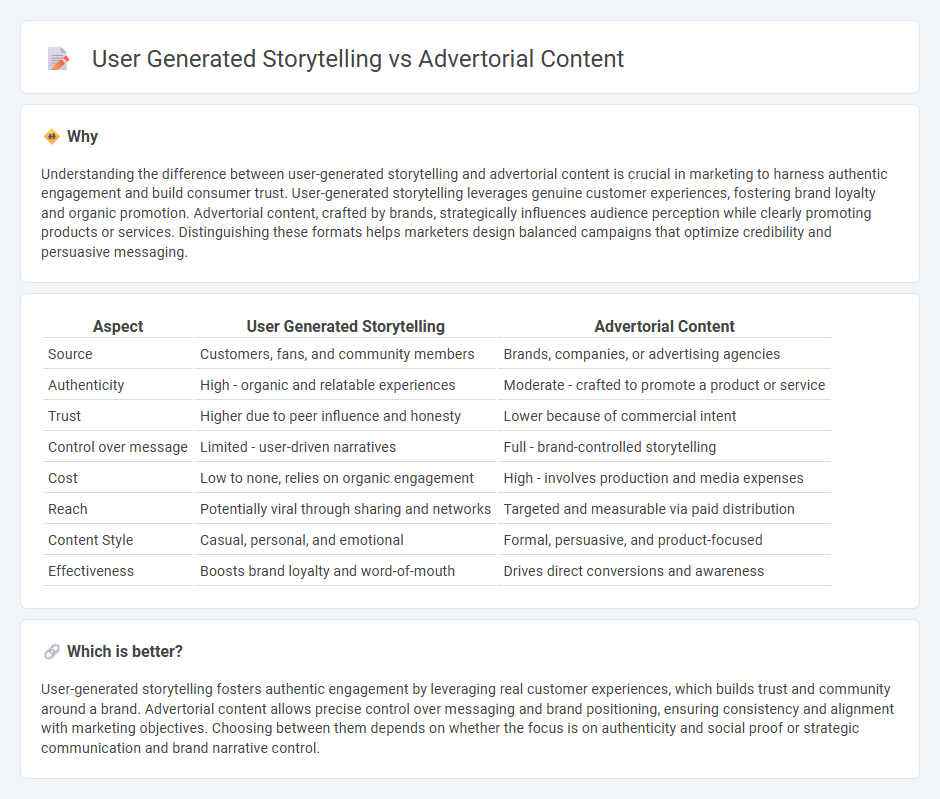
User-generated storytelling leverages authentic customer experiences to build trust and foster engagement by showcasing real-life interactions with a brand. Advertorial content combines advertising and editorial elements to deliver promotional messages in an informative, narrative-driven format that aligns with the target audience's interests. Discover how integrating both strategies can elevate your marketing approach and drive impactful connections.
Why it is important
Understanding the difference between user-generated storytelling and advertorial content is crucial in marketing to harness authentic engagement and build consumer trust. User-generated storytelling leverages genuine customer experiences, fostering brand loyalty and organic promotion. Advertorial content, crafted by brands, strategically influences audience perception while clearly promoting products or services. Distinguishing these formats helps marketers design balanced campaigns that optimize credibility and persuasive messaging.
Comparison Table
| Aspect | User Generated Storytelling | Advertorial Content |
|---|---|---|
| Source | Customers, fans, and community members | Brands, companies, or advertising agencies |
| Authenticity | High - organic and relatable experiences | Moderate - crafted to promote a product or service |
| Trust | Higher due to peer influence and honesty | Lower because of commercial intent |
| Control over message | Limited - user-driven narratives | Full - brand-controlled storytelling |
| Cost | Low to none, relies on organic engagement | High - involves production and media expenses |
| Reach | Potentially viral through sharing and networks | Targeted and measurable via paid distribution |
| Content Style | Casual, personal, and emotional | Formal, persuasive, and product-focused |
| Effectiveness | Boosts brand loyalty and word-of-mouth | Drives direct conversions and awareness |
Which is better?
User-generated storytelling fosters authentic engagement by leveraging real customer experiences, which builds trust and community around a brand. Advertorial content allows precise control over messaging and brand positioning, ensuring consistency and alignment with marketing objectives. Choosing between them depends on whether the focus is on authenticity and social proof or strategic communication and brand narrative control.
Connection
User-generated storytelling and advertorial content intersect through authentic narrative engagement that enhances brand credibility and consumer trust. By leveraging real customer experiences and opinions within advertorial formats, marketers create compelling, relatable content that drives higher conversion rates and strengthens brand loyalty. This synergy amplifies social proof, making marketing campaigns more persuasive and impactful.
Key Terms
Authenticity
Advertorial content often prioritizes brand messaging and controlled narratives, which can sometimes compromise perceived authenticity. User-generated storytelling taps into genuine customer experiences and emotional connections, enhancing trust and relatability for audiences. Discover how leveraging authentic user stories can elevate your marketing strategy and foster deeper consumer engagement.
Credibility
Advertorial content often blends promotional messaging with informative elements, aiming to build credibility through controlled storytelling and expert endorsements. User-generated storytelling enhances credibility by showcasing authentic experiences and genuine emotions, fostering trust and engagement among audiences. Explore deeper insights into how these approaches impact brand trust and consumer perceptions.
Engagement
Advertorial content blends promotional messaging with informative narratives designed to maintain reader interest, often achieving higher initial impressions but potentially lower trust compared to authentic user generated storytelling. User generated storytelling fosters genuine emotional connections and credibility, driving sustained engagement through relatable experiences and community participation. Explore strategies to balance both methods for maximizing audience interaction and loyalty.
Source and External Links
The Ultimate Guide to Advertorials - An advertorial is a paid article designed to look and read like editorial content, with the goal of promoting a product or service while aligning with the publisher's style, often leading the reader toward a specific action.
What is an Advertorial? - An advertorial is an advertisement that mimics the format and tone of an editorial or informative article, presenting information about a brand or product in a less overtly promotional way.
Advertorials 101: A Detailed Guide to Design With Examples - Advertorials combine storytelling and valuable content with a clear call to action, aiming to engage readers and drive conversions without appearing overly promotional.
 dowidth.com
dowidth.com